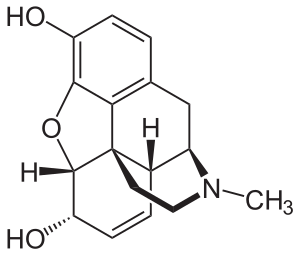Morphine
Morphine also referred to as morphium in medicine, is a natural opioid, obtained from opium, i.e. the resin of the poppy (Papaver somniferum), in which it is present together with codeine in an amount of 3-13%. It is used as a general anesthetic but is also abused as a drug. Its addiction potential is high.
Indication[edit | edit source]
Particularly as a general anesthetic and for severe pain management.
Pharmacokinetics and pharmacodynamics[edit | edit source]
Usual application - intravenously, in the brain (primarily in the limbic region) it acts on opiate receptors. The duration of the effect is around 4-5 hours, less for chronic users. In orientation tests for drugs, it is usually conclusive even several days after use (from blood, saliva, urine, and hair).
Effects[edit | edit source]
- sedation, a feeling of well-being and euphoria, with large doses sleep or coma;
- reduction of the cough reflex;
- pain relief;
- depression of the respiratory center − decrease in respiratory rate, increase in volume;
- reduction of intestinal motility - the use of opiates generally results in spastic constipation;
- nausea to vomiting.
Signs of intoxication[edit | edit source]
- miosis, respiratory depression, circulatory disorders, apathy, coma;
- in case of overdose, naloxone or partial agonist-antagonists (nalbuphine) are used as a specific antidote;
- acute withdrawal symptoms may occur when naloxone is administered.
Abuse[edit | edit source]
Addiction can develop very quickly, within weeks. In most cases, the user soon transitions to intravenous use. Users tend to be apathetic, spending most of their time procuring the drug, the means to buy it, or recovering from the consequences. Moreover, there is a risk of infection, HIV, and viral diseases when sharing injection equipment.
Links[edit | edit source]
Related Articles[edit | edit source]
Bibliography[edit | edit source]
- RAHN, Ewald – ANGELA, Mahnkopf. Psychiatrie : Učebnice pro studium a praxi. 1. edition. Grada - Publishing, 2000. pp. 283-284. ISBN 80-7169-964-0.
- NĚMEC, Karel, et al. Wikiskripta : Poruchy vyvolané užíváním opioidů [online]. MEFANET, ©2010. The last revision 2012, [cit. 2014-03-12]. <https://www.wikiskripta.eu/w/Poruchy_vyvolan%C3%A9_u%C5%BE%C3%ADv%C3%A1n%C3%ADm_opioid%C5%AF>.
- HESS, Ladislav. Opiáty [lecture for subject Anesteziologie a neodkladná medicína, specialization Všeobecné lékařství, 2. lékařská fakulta Univerzita Karlova]. Praha. 2014.
References[edit | edit source]
- SINGH, Sanjay. Drugs.com : Morphine [online]. ©2008. The last revision 2008, [cit. 2015-11-03]]. <<https://www.drugs.com/morphine.html>>.
- LÜLLMANN, Heinz, et al. Farmakologie a toxikologie : Učebnice pro studium a praxi. 2. edition. Grada, 2004. pp. 725. ISBN 80-247-0836-1.


